
Preparing Your Flock for Old Man Winter.
Summer has surrendered to fall, leaves wrestle in the wind, fall, then scatter on the ground. The gardens have been harvested, tilled under and prepared for the coming seasons rest. The girls are finishing their yearly molt, roosting increasingly earlier each evening. All this signifies the coming of winter, along with all its challenges for the backyard chicken keeper.

Many new backyard chicken keepers find themselves intimitated and overwhelmed wondering how to overwinter their flock. I know because I have been there. Over the years, I have learned a trick or two on how to keep your girls happy, healthy, and comfortable as outside temperatures plummet and winter weather rages.

The secret to successfully overwintering your flock is to keep it simple, enhancing your flocks naturally ability to weather the elements. Many new backyard chicken owners make the mistake of judging their flocks comfort by their own. This is the first and essentially the riskiest mistake that a flock owner can make. This is true for several reasons.
- Chickens come factory installed with a down coat, the same coat that we put on when the mercury dips below a certain point. Many owners often forget that their ladies and gents are already bundled up for winter. Increasing the temperature in the coop hinders their health and can even cause death. Reasons are these.
- Heating the coop: Additional heat to the coop or pen hinders the flocks ability to naturally adjust to falling temps. In the presence of a heated coop, your ladies will fail to grow in the down coat necessary for winter temperatures. This becomes problematic in events such as a winter storm knocking out power for hours or even days. The flock has acclimated to a warmer living environment, when this heat source is abruptly removed, shock and death can result. Like us, if resources to keep warm are removed, inability to adequately adapt to the cold environment may result in one falling prey to the harsh conditions . In the same situation we put on warmer cloths, huddle under blankets, sit by a fire, or drink and eat warm substances. All these necessities are not available to the backyard flock who suddenly finds themselves freezing due to depedence on a heat source. This is the first and the most serious mistake that a backyard chicken keeper can make. It is best to let them adjust to the cooler temps gradually, growing in their thick and heavy down coat as nature intended.
- Heat lamps: The second mistake that new backyard chicken owners can make is the use of the humble heat lamp. Heat lamps = coop fires!!! I cannot recount how many times I saw on social media or heard about coops destroyed due to heat lamps. Heat lamps are very dangerous for a variety of reason, when used as a winter heat source, they can be deadly. Heat lamps, (sometimes called brooder lamps), consist of a large 500 watt red bulb that is used to create a warm environment to raise chicks. While heat lamps are a danger even when used as a brooder heat source, they are even more dangerous when used around adult birds in an enclosed space. Why? There is no way to safely mount a 500 watt heat lamp in an enclosed space where the occupants can fly, accidentally knocking them down. With a coop full of pine shavings, dry straw, dust and feathers, this is perfect kindling and prime to start a fast, furious and complete coop fire. If you take anything away from this post please, please do not use heat/brooder lamps to heat your coop. They will in most cases cause a devastating disaster. There are much better natural ways to assist your girls in overwintering the cold months. Below I will share with you safe methods that I employ to keep my flock happy, healthy, entertained and content during the long winter season.
But first, let’s answer a simple question. What does a backyard flock need in order to weather the worst of Old Man Winter? The needs of backyard chickens in winter are very few. All they really need is a clean and dry place to call home. They do the rest. It is the job of a keeper to provide the necessary accommodations in order to meet their basic needs. Chickens are well adapted to live outside, all they need is a little help to weather the bitter winds and elements.
How is this achieved? The main thing I do to overwinter my flock is enclosing their pen with construction grade plastic sheeting. The purposes are tripple fold.
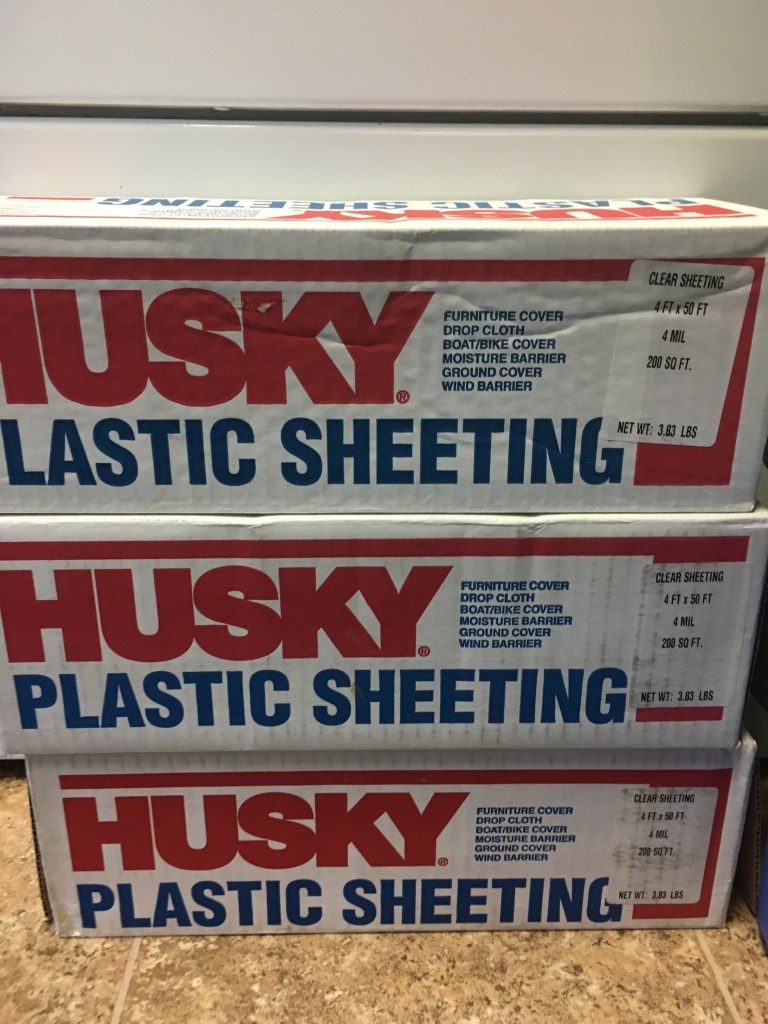

- Wind Break: The plastic acts as a wind break. As the bitter winter winds blow, the plastic surrounding the pen blocks the wind, allowing the girls to retain their body heat. Chickens are more than capable of generating their own body heat. Using their feathers and down coats, they can regulate heat their bodies produce, thereby keeping warm in the winter. The cold winter winds disrupt this thermal regulation by lifting up their feathers, exposing their skin to the bitter winter winds, loosing the warmth they worked so hard to maintain. A simple wind barrier helps them immensely. If allowed access to free range on a cold day, they will come and go from the protected pen as needed depending on their individual needs. If it’s a cold day, they will stay in the wind free environment of the pen. If it’s warmer, they may spend more time outdoors hunting and pecking. Allowing them access to the outdoors while providing a wind free place to retreat, will keep them happy and content as they weather Old Man Winter.
- Precipitation Barrier: The plastic keep the elements out of the pen, providing a dry place to call home. We are all familiar with the mystery that the cold winter rains can elitist. The same can be said for the snow and ice. Chickens prefer to avoid these elements if they can. However, since they live outside, their options may be few. This is another benified of enclosing the pen with plastic sheeting. As the elements rage outside, the girls are protected from the snow, rain, sleet, and ice that pleague the winter season. This simple barrier from the elements creates a dry and wind free place for your flock to call home. Simply keeping the elements out of the pen helps them immensely as they weather the worst of Old Man Winter. If protected from the wind and precipitation, the cold temperatures are not an issue for the flock.
- Clean and Dry Digs: Providing clean and dry digs for your flock is essential. Along with providing a wind and precipitation break, a clean coop and pen goes a long way. The flock will undoubtedly spend more time in the protection of the coop/pen during winter. It’s a keepers job to see that their digs remain clean and dry. This is simply done by making sure the coop and pen are cleaned and maintained on a daily basis. This is necessary to keep moisture down their living areas. We all know that chicken poo can be wet and sticky. Due to the moisture content of their poo, this creates the ideal situation for frost bite. When too much moisture is presnent in the coop, frost bite will settle on the combs and wattles of your roosters and larger combed ladies. Removing the poo daily from both the coop and pen prevents these conditions. Frost bite is no fun, it hurts and can be dangerous if not properly treated. As they say, an ounce of prevention is better than a cure.
By simply enclosing your coop/pen in construction grade plastic, you provided a condusive habitat for your flock to weather Old Man Winter. Below are some pictures of my coops and pens that have been prepared for the coming bitter season.

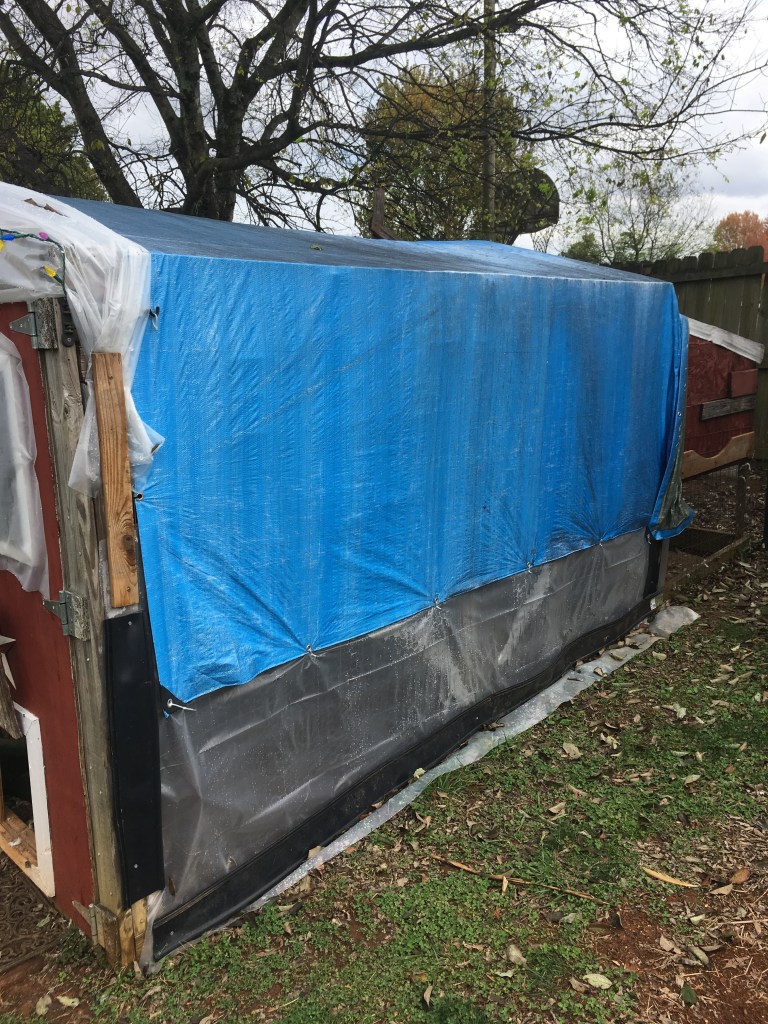
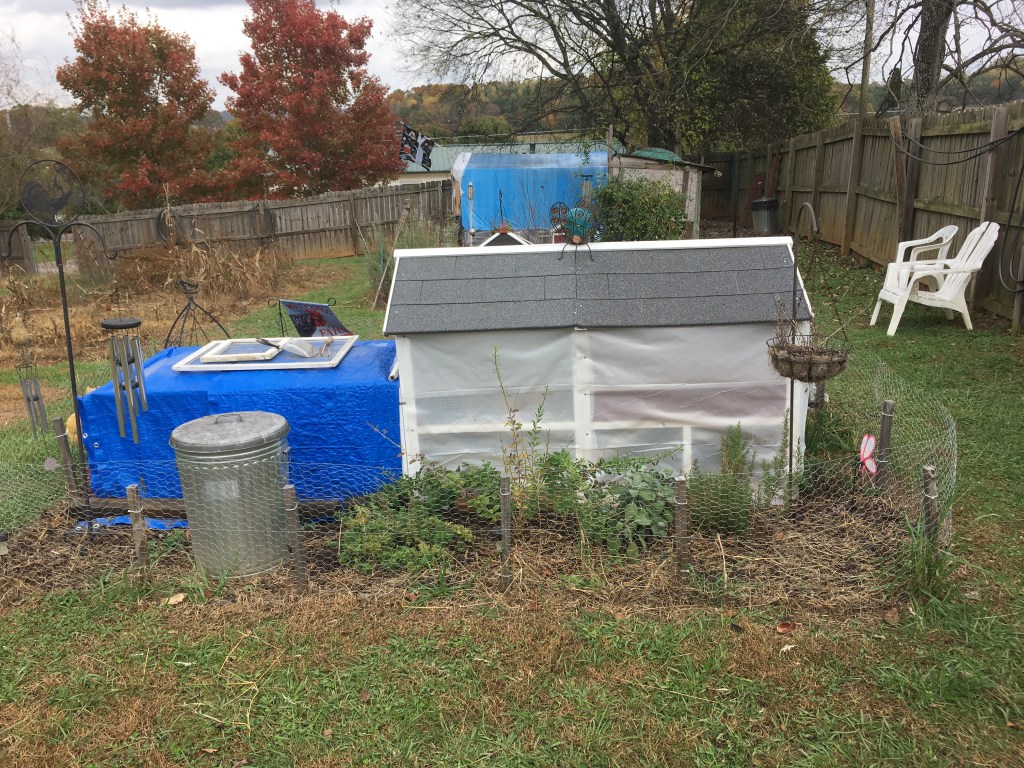
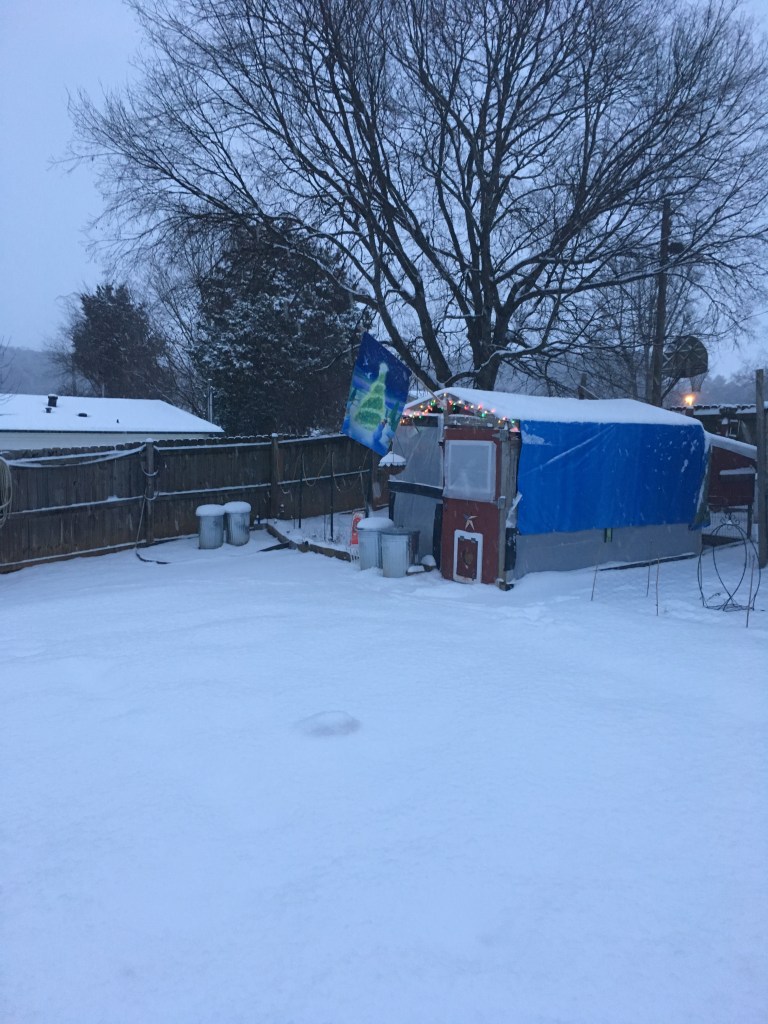

As the bitter weather rages, the girls will be safe and warm in their pens. Below are some pictures of the ladies braving the elements in their winter digs.

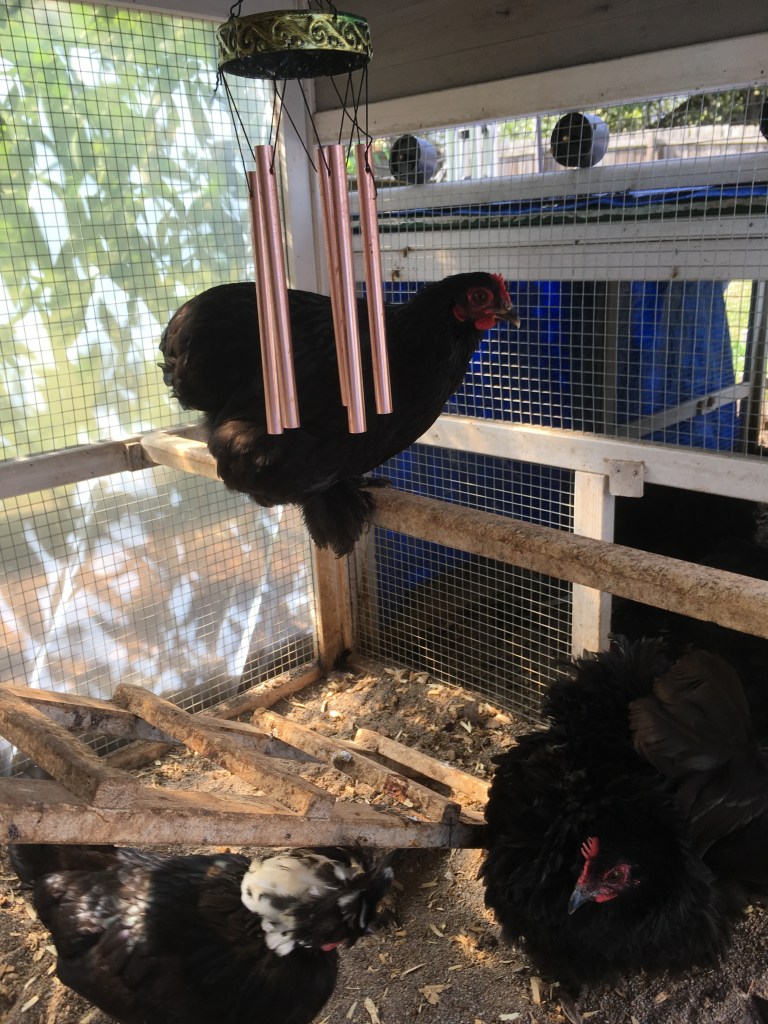
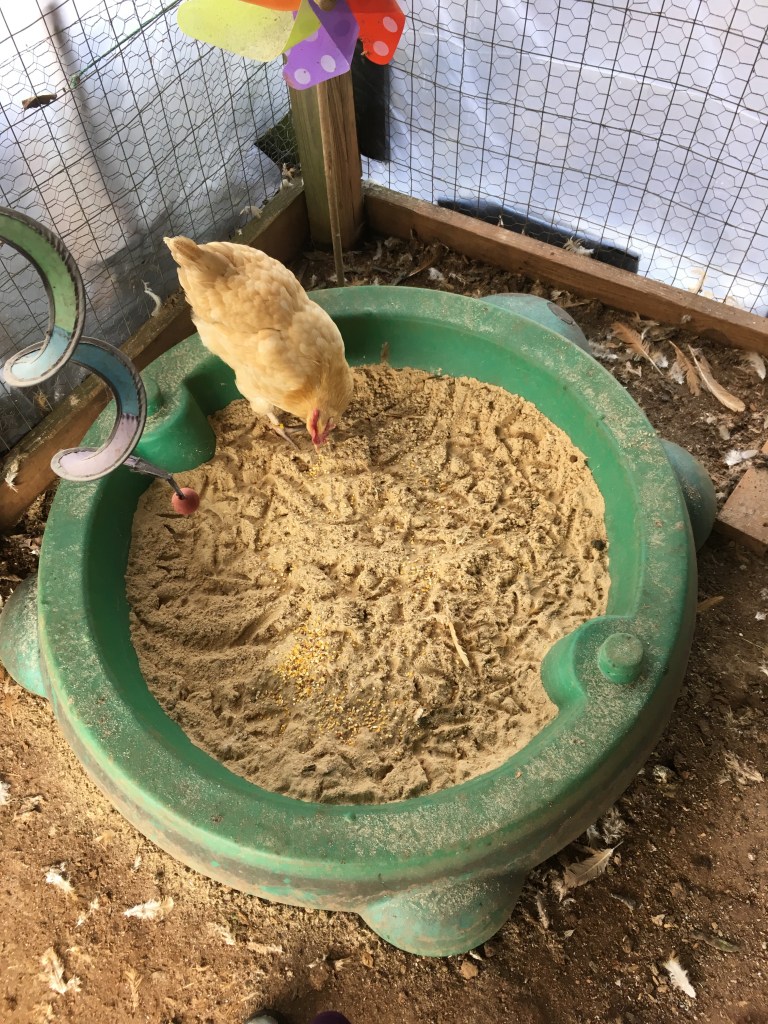



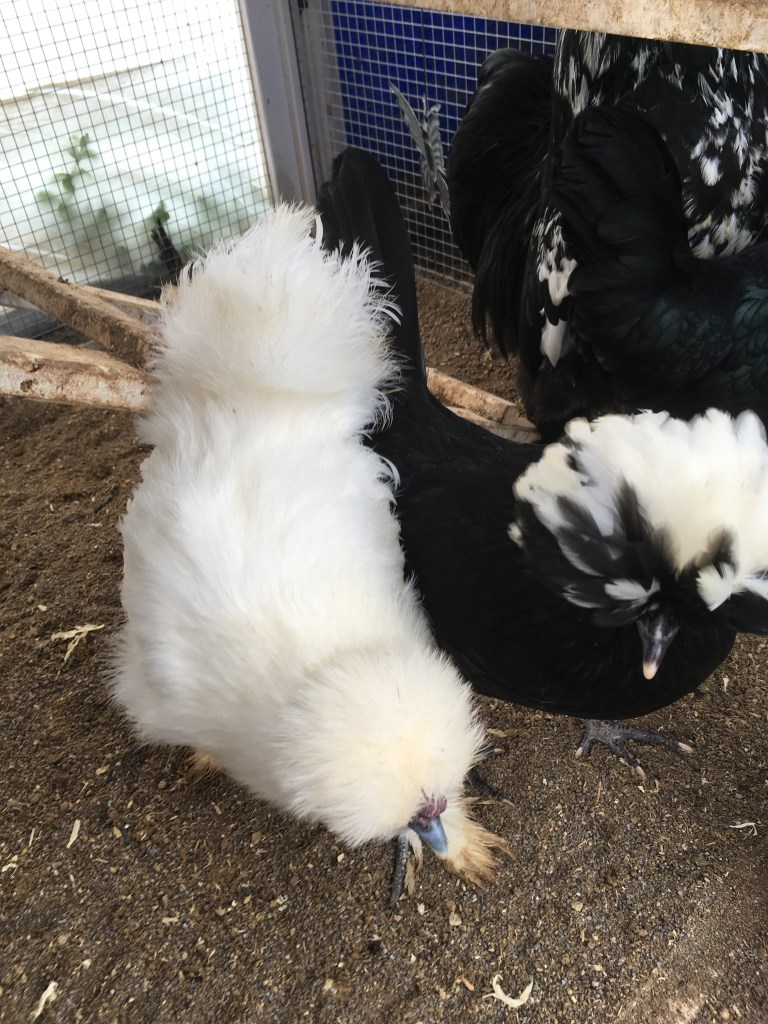
Along with enclosing the coops and pens in plastic, providing your flock with some entertainment will go a long way. During the coldest days, your flock will undoubtedly spend more time in their pen. If this occurs for consecutive days, they may begin to suffer from coop boredom. Just like us, if we spend a lot of time in a tight enclosure, we get a little restless and bored. Chickens are no different, it left too long in these conditions, they will begin to peck at each other, creating injury and a hostile flock environment. To prevent this, provide games to play and things to peck. Below are a few things that I do for my flock, keeping them happy and healthy.
- Flock Block: A flock block is a very simple entertainment tool I often use during the harshest part of winter. Additionally, due to the fact that they are unable to forage for grains and seeds, a flock block provides these nutrients. Flock blocks are large blocks that consists of seeds and other goodies compacted in a hard square shaped formation. The chickens will spend hours happily pecking at the block, keeping them entertained for days on end. One block will last my flock for an entire winter. They are found at most feed stores, usually under $20. It is also possible to make your own. At the end of this post, I will leave a recipe that I use when I want something a little more tailor made for my girls.

2. Peck the Bottle: This is a little chicken game that keeps my girls busy for hours. Additionally, it is very entertainment to watch them peck at the bottle. The supplies needed for this game are very simple. An empty plastic water bottle add some scratch or cracked corn. Take the bottle and poke some small holes large enough for the corn or scratch to fall through. Inside the bottle, fill the bottle half full of the treat. Place the bottle in the pen.
The flock will peck at the bottle, trying to free the corn or scratch contained inside. One by one, the flock will each peck at the bottle, moving it around the pen in efforts to consume the treat. This will keep a flock busy for days. If you have a larger flock, place a few more bottles in the pen. If you want to step up their game, fill the bottle with dry meal worms. Your flock will go crazy, working extra hard to get the worms out of the bottle.

3. Cabbage in a basket: If you want to add some greens to your chickens winter diet, veggies in a basket or suit feeder is a great choice. With grass and other delectables long since dormant for the season, greens are in short supply. To supplement your ladies diet with green veggies, this winter time trick is ideal. Simply take a suit feeder, open it, and place the veggies inside. Hang the feeder in the coop and let the games begin. Your ladies will go crazy for some fresh greens. Since it is cold outside, the greens will stay fresh for a while. Once the suit cage is empty, refill and play again. You can also put a head of cabbage in a metal hanging basket, placing it in the pen or yard for you girls to pick at. They will enjoy the fresh greens, all the while staying healthy and entertained.

4. Sand Box Spa: As winter sets in, the ground becomes covered, saturated with snow or rain, the girls will find it hard to keep up their beauty regiments. Simply placing a sand box in the pen and filling it with sand goes a long way. If your pen is too small for fit a sand box, pour the sand directly on the pen floor. Not only does this provide them a place to dust bath, it is also provides them a great way to scratch around.
Chickens love to scratch at the ground as they hunt and peck for delectable to dine on. In winter however, this past time is hindered due to the ground conditions caused by winter. To keep them further entertained, sprinkle some scratch or mealworms on top of the sand and watch the fun begin. They will spend hours digging in the sandbox, making sure that they have found and consumed every last morsel. This will quickly become a flock activity that they love and relish during the cold miserable days of winter.

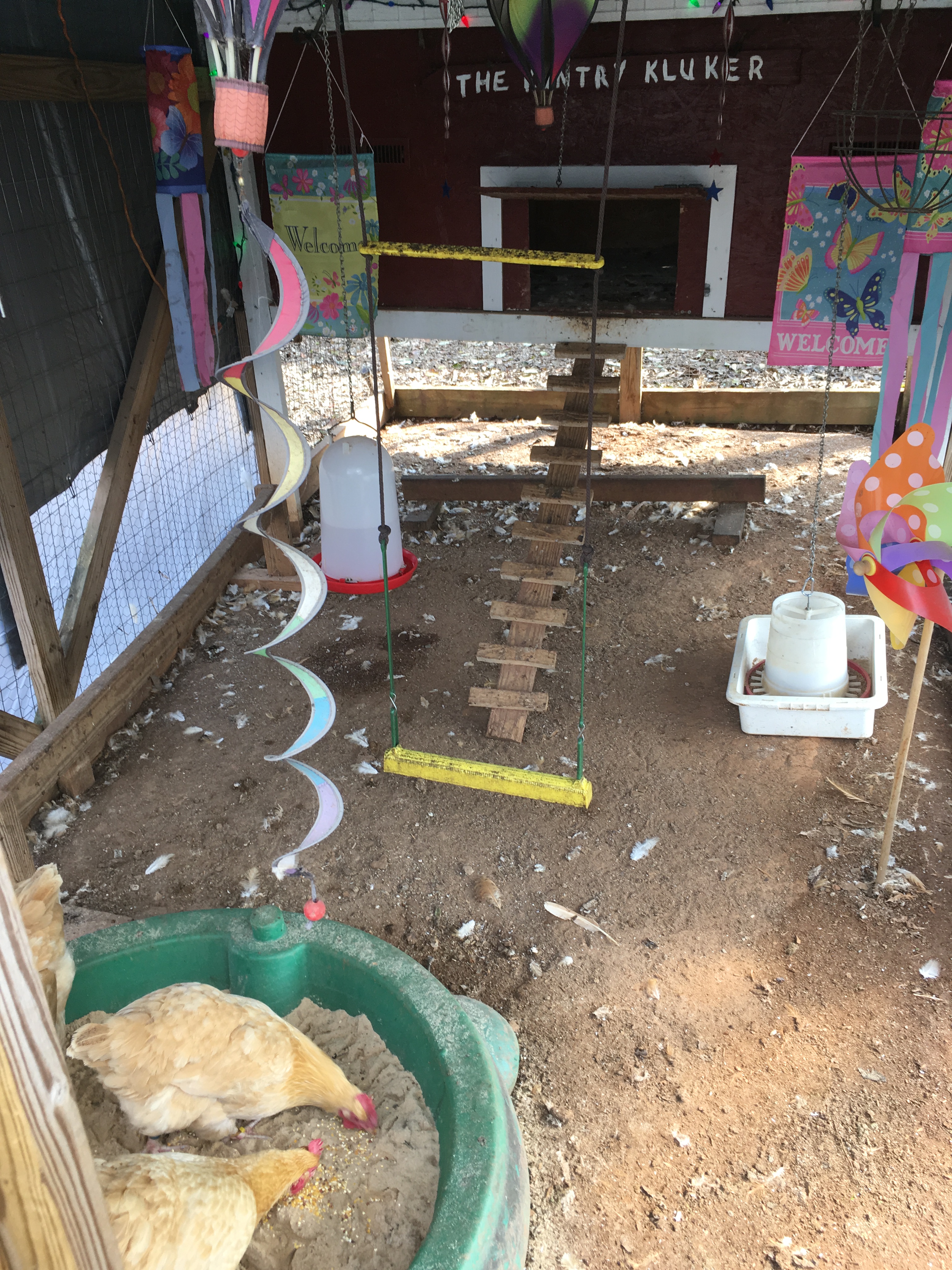

Finally, I come to my last tip for winter care for your flock, water. Many keepers underestimate the need for clean and fresh water during the winter months. While they will drink more water in the summer to stay hydrated and cool, water is necessary for them to regulate their body temperature. During the cold months while a flock is working hard to regulate their body temperature, water is essential. For their little bodies to keep their furnaces stoked, access to liquid water is necessary. One of the major hinderances to this process is the cold temps causing the water to freeze. To combat this, I use several methods.
- The haul it method: For those who do not have a large flock, simply hauling fresh unfrozen water to the backyard several times a day is ideal. If your flock is small and someone is at home during the day, this is the simplest and cheapest method to combat freezing waterers. Since it requires no electricity or expensive accessories, this method is best if applicable.
- Heated waterer: If your flock is larger and no one is home to see to the water needs of the flock, a heated waterer is ideal. Although these waterers are a little bit on the pricy side, they are a life saver. You can find electric heated waterer at most feed stores. They range from $40 to $60 and long lasting. I am still using the one I purchased 5 years ago and its still going strong.

3. Light bulb in a metal tin: The last method that I use is the light bulb in a metal tin. Like the heated poultry drinker, this method requires electricity supplied to your coop. If you have several coops, purchasing a heated poultry drinker for each one can get expensive. I use the purchased heated drinker for my largest coop, the rest I use this simpler method.
Simply take a metal tin (cookie or other round tin), drill a hole just large enough for a cord, string the cord through the hole in the tin, purchase a light bulb and a socket cord (used for restiringing lamps) and simply screw the light bulb into the socket that is connected to the tin. Put the tin lid on, place the plastic or metal drinker on top and presto, you have a heated poultry drinker.
The radiant heat from the bulb will keep the water from freezing. Since all you need to keep the water warm enough to remain liquid a 15 or 25 watt bulb is best. You don’t want to heat the water too high, making it too warm for the flock drink. The goal here is to keep the water from freezing. This low watt bulb will supply just enough heat to keep the water in a liquid, drinkable state. If you don’t have any metal tins around suitable for this purpose, a terra cotta flower put turned upside down will also do the trick.

That’s a wrap. Above are all the techniques, tools and tricks of the trade I use to keep my flock happy, healthy, and content during the harsh winter months. As promised, below I will leave the recipe that I use to make a homemade suit treat for my girls. The ingredients used in this flock treat are typically found in every kitchen and cheap to purchase if needed.
The Kuntry Klucker Crew’s Favorite Flock Block
2 cups scratch grains
1 cup layer feed
1 cup old-fashioned oats
1 1/2 cup of raisins (for added fun)
1/4 cup whole wheat flower
1 teaspoon ground cinnamon (aids in respiratory health)
1/2 teaspoon cayenne pepper (helps circulation)
3 whole eggs (provides calcuim , shells included, crushed to fine pieces)
1/2 cup blackstrap molasses
1/2 coconut oil, liquified
preheat oven to 325 degrees. In a large mixing bowl, mix the dry ingredients. Add the wet ingredients and mix well. Pat into several small baking dishes, so your blocks are approximately 2″ thick (this way they can fit into suit feeders).
If you plan to hang the flock block treat in your chicken pen, use a chopstick to make a hole large enough for twine or rope to fit though.
Bake for 30 minus, then cool completely. If you try to remove them from the pan while still warm they will fall apart. Once cool, run a knife around the inside rim of each pan and invert to remove the block. Serve to a flock of very happy girls.
Leftovers can be refrigerated or wrapped in foil and frozen then defrosted as needed.
Enjoy!!
I hope you have enjoyed reading this post and found it helpful or useful. If you have any questions please post them in the comments.
As always, thanks for reading. Till next time, keep on crowing!
~ The Kuntry Klucker Crew ~
